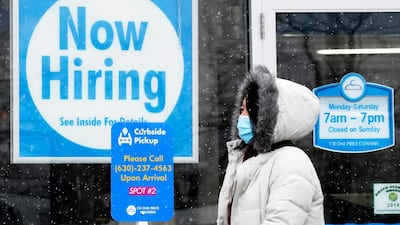The US economy created more jobs than expected in February as falling new Covid-19 infections and additional pandemic relief money from the government boosted hiring at restaurants and other services businesses, firmly putting the labour market recovery back on track.
Though job growth momentum is expected to build in the months ahead amid an acceleration in the pace of vaccinations and more fiscal stimulus, it will probably take several years for the labour market to heal from the deep scars inflicted by the coronavirus pandemic, which is now in its second year.
Another 3.5 million have permanently lost their jobs. The Labour Department's closely watched employment report on Friday showed at least 4.1 million people have been out of work for more than six months, accounting for 41.5 per cent of the unemployed population in February.
"There remains easy fuel for strong payroll gains in coming months as the reopening gains momentum," said Robert Rosener, an economist at Morgan Stanley in New York.
"But there is much further to go before conditions are consistent with maximum employment."
Non-farm payrolls surged by 379,000 jobs last month after rising 166,000 in January. Payrolls fell in December for the first time in eight months. The economy has recouped 12.7 million of the 22.2 million jobs lost in the pandemic recession.
Economists polled by Reuters had forecast February payrolls increasing by 182,000 jobs. Restaurants and bars hired 286,000 workers last month, accounting for 75 per cent of the payrolls gain. There were also increases in employment at hotels and motels and at amusement, gambling and recreation establishments. Altogether, leisure and hospitality employment jumped by 355,000 jobs.
Temporary help, a harbinger for future hiring, increased further. Healthcare and social assistance also added jobs, and retailers hired 41,000 workers. Manufacturing payrolls increased by 21,000 jobs. About half of the factory job gains were in transport equipment, despite a global semiconductor chip shortage, which has forced some car makers to cut production.
But construction employment decreased by 61,000 jobs because of bitter cold across the country. Government payrolls dropped by 86,000 jobs, with losses concentrated in state and local governments. The diffusion index, or measure of private industries expanding, jumped to 57.0 from 48.4 in January.
The surge in hiring follows on the heels of a strong rebound in consumer spending in January, which prompted economists to sharply upgrade their growth estimates for the first quarter.
A decrease in daily coronavirus cases and hospital admissions and about $900 billion in stimulus provided by the government at the end of December are driving the revival in economic activity and hiring. That has stoked inflation fears.
The White House is not backing down on President Joe Biden's $1.9 trillion recovery plan. Economists have warned the package combined with the Federal Reserve's near-zero interest rates and bond purchases could cause the economy to overheat.
US Treasury yields have jumped as investors see higher inflation.
"We will always be rooting for more job growth for more Americans across the board," National Economic Council Director Brian Deese told CNBC. "We think that if we pass this rescue plan right now, we could be poised for really strengthening the economy and getting to full employment significantly faster than most forecasters estimate without this plan."
Federal Reserve head Jerome Powell on Thursday again brushed aside the inflation concerns, saying he expected the US central bank "will be patient" until the economy is "very far along the road to recovery".
Stocks on Wall Street were trading lower. The dollar rose against a basket of currencies though US Treasury prices were mixed.
Even as the labour market recovery is regaining steam, ample slack remains. Though the unemployment rate fell to 6.2 per cent last month from 6.3 per cent in January, it continued to be understated by people misclassifying themselves as being "employed but absent from work." Without this problem, the unemployment rate would have been 6.7 per cent. It is about 9.5 per cent, including people who have given up the search for work.
A broader measure of unemployment, which includes people who want to work but have given up searching and those working part-time jobs because they cannot find full-time employment, was unchanged at 11.1 per cent. Unemployment remains high among blacks and Hispanics, as well as Americans without high school diplomas or college degrees.
The labour force participation rate, or the proportion of working-age Americans who have a job or are looking for one, was steady at 61.4 per cent in February. The participation rate has tumbled from 63.3 per cent in February 2020, with women accounting for the biggest share of dropouts.
According to Census Bureau data, about 10 million mothers living with their own school-age children were not actively working in January, 1.4 million more than during the same month in 2020.
"The Fed wants a 'broad' recovery in the labour market across income and racial groups," said Joseph Song, a US economist at Bank of America Securities in New York. "So, while there is meaningful improvement, the labour market is far from returning to normal."
With the lower-wage leisure and hospitality industry accounting for 94 per cent of payrolls growth last month, average hourly earnings gained 0.2 per cent. Unseasonably cold weather shortened the average workweek to 34.6 hours from 34.9 hours.

